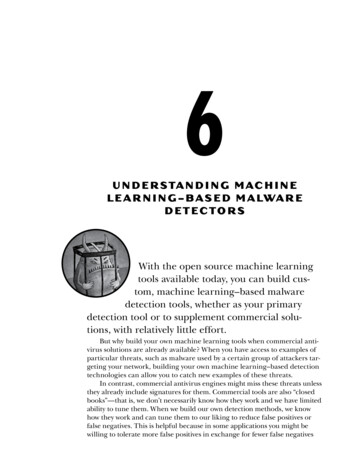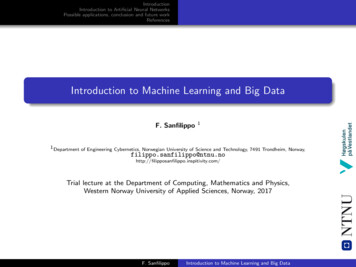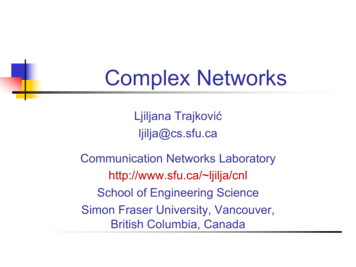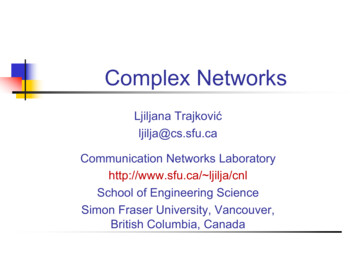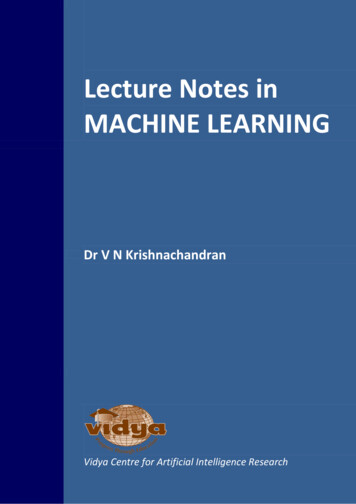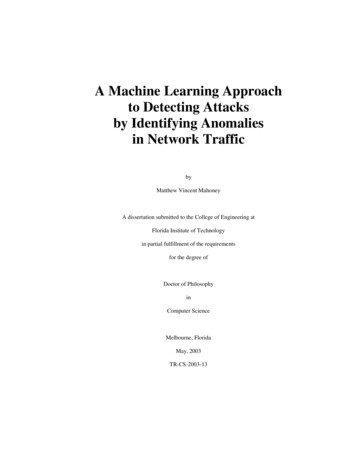
Transcription
A Machine Learning Approachto Detecting Attacksby Identifying Anomaliesin Network TrafficbyMatthew Vincent MahoneyA dissertation submitted to the College of Engineering atFlorida Institute of Technologyin partial fulfillment of the requirementsfor the degree ofDoctor of PhilosophyinComputer ScienceMelbourne, FloridaMay, 2003TR-CS-2003-13
Copyright 2003 Matthew Vincent MahoneyAll Rights ReservedThe author grants permission to make single copies
A Machine Learning Approach to Detecting Attacks by Identifying Anomalies in Network Traffica dissertation byMatthew Vincent MahoneyApproved as to style and contentPhilip K. Chan, Ph.D.Associate Professor, Computer ScienceDissertation AdvisorRyan Stansifer, Ph.D.Associate Professor, Computer ScienceJames Whittaker, Ph.D.Professor, Computer ScienceKamel Rekab, Ph.D.Professor, Mathematical SciencesWilliam D. Shoaff, Ph.D.Associate Professor, Computer ScienceDepartment Head
AbstractA Machine Learning Approach to Detecting Attacks by Identifying Anomalies in Network TrafficbyMatthew Vincent MahoneyDissertation Advisor: Philip K. Chan, Ph.D.The current approach to detecting novel attacks in network traffic is to model the normalfrequency of session IP addresses and server port usage and to signal unusual combinations of theseattributes as suspicious. We make four major contributions to the field of network anomalydetection. First, rather than just model user behavior, we also model network protocols from thedata link through the application layer in order to detect attacks that exploit vulnerabilities in theimplementation of these protocols. Second, we introduce a time-based model suitable for the burstynature of network traffic: the probability of an event depends on the time since it last occurred ratherthan just its average frequency. Third, we introduce an algorithm for learning conditional rules fromattack free training data that are sensitive to anomalies. Fourth, we extend the model to cases whereattack-free training data is not available.On the 1999 DARPA/Lincoln Laboratory intrusion detection evaluation data set, our bestsystem detects 75% of novel attacks by unauthorized users at 10 false alarms per day after trainingonly on attack-free traffic. However this result is misleading because the background traffic issimulated and our algorithms are sensitive to artifacts. We compare the background traffic to realtraffic collected from a university departmental server and conclude that we could realisticallyexpect to detect 30% of these attacks in this environment, or 47% if we are willing to accept 50 falsealarms per day.iii
Table of ContentsList of Figures. ixList of Tables. xAcknowledgments . xiDedication . xii1. Introduction . 11.1. Problem Statement . 31.2. Approach . 41.3. Key Contributions . 61.4. Dissertation Organization. 62. Related Work. 92.1. Network Vulnerabilities . 92.1.1. Probes. 102.1.2. Denial of Service Attacks. 122.1.3. Remote to Local Attacks. 132.1.4. Attacks on the Intrusion Detection System . 142.2. Properties of Network Traffic . 162.3. Intrusion Detection . 192.3.1. Machine Learning . 192.3.2. Network Signature Detection . 222.3.3. Host Based Anomaly Detection . 222.3.4. Network Anomaly Detection . 232.4. Intrusion Detection Evaluation. 253. Time-Based Protocol Modeling. 30iv
3.1. Protocol Modeling. 303.2. Time Based Modeling . 323.3. PHAD. 353.4. Experimental Procedure . 363.5. Experimental Results. 373.5.1. Attacks Detected . 383.5.2. False Alarms . 403.5.3. Detection – False Alarm Tradeoff. 413.5.4. Detections by Category . 423.5.5. Implementation and Run Time Performance . 433.6. Summary . 434. Application Layer Modeling. 454.1. ALAD. 454.2. Experimental Results. 484.2.1. Client Address Detections. 504.2.2. TCP State Detections . 504.2.3. Keyword Detections. 514.2.4. Keyword Argument Detections. 534.2.5. Server Address/Port Detections . 544.2.6. Detection – False Alarm Tradeoff. 544.2.7. Detections by Category . 554.2.8. Implementation and Run Time Performance . 564.3. Summary . 565. Learning Conditional Rules. 585.1. Rule Learning. 595.1.1. Generating Candidate Rules. 59v
5.1.2. Removing Redundant Rules. 615.1.3. Removing Poorly Performing Rules . 625.1.4. Alarm Generation. 635.2. Experimental Evaluation . 645.2.1. Experimental Data and Procedures . 645.2.2. Experimental Results . 655.2.3. Detection – False Alarm Tradeoff. 675.2.4. Detections by Category . 685.2.5. Implementation and Run Time Performance . 695.3. Summary . 696. Continuous Modeling . 716.1. Modeling Previously Seen Values. 716.2. NETAD . 736.3. Experimental Results. 756.3.1. Detections by Category . 786.3.2. Detection – False Alarm Tradeoff. 796.4. Unlabeled Attacks in Training. 806.5. Implementation and Run Time Performance. 826.6. Summary . 827. A Comparison of Simulated and Real Traffic . 837.1. Traffic Collection . 857.1.1. Environment. 867.1.2. Data Set. 877.2. Comparison with Real Traffic . 887.2.1. Comparison of All Filtered Packets . 907.2.2. Comparison of TCP SYN Packets . 93vi
7.2.3. Comparison of Application Payloads. 957.3. Summary . 988. Evaluation with Mixed Traffic . 998.1. Data Preparation. 1018.2. Algorithm Preparations . 1028.2.1. PHAD Modifications . 1028.2.2. ALAD Modifications . 1038.2.3. LERAD Modifications . 1058.2.4. NETAD Modifications. 1078.2.5. SPADE Modifications. 1078.3. Evaluation Criteria . 1088.4. Experimental Results. 1108.4.1. PHAD Results . 1118.4.2. ALAD Results. 1138.4.3. LERAD Results. 1148.4.4. NETAD Results . 1158.4.5. SPADE Results . 1178.5. Results Analysis . 1188.6. Summary . 1219. Conclusions . 1239.1. Summary of Contributions . 1239.2. Limitations and Future Work . 126References . 129Appendix A: Example LERAD Run . 135A.1. Rules. 135A.2. Detected Attacks. 140vii
A.3. Top Scoring Alarms . 145viii
List of Figures2.1. DARPA/Lincoln Labs IDS Evaluation Test Configuration. 263.1. PHAD DFA Curve. 414.1. ALAD DFA Curve . 555.1. LERAD Candidate Rule Generation Algorithm . 605.2. LERAD Redundant Rule Elimination Algorithm. 625.3. LERAD Rule Validation Algorithm . 635.4. LERAD DFA Curve . 686.1. NETAD DFA Curve . 797.1. Good vs. Bad Rules . 908.1. Mapping Real Time to Simulation Time . 1018.2. LERAD/NETAD DFA Curve on Simulated and Mixed Traffic . 120ix
List of Tables2.1. Top Results in the 1999 IDS Evaluation . 283.1. PHAD Detections by Category. 424.1. ALAD Detections by Rule Form . 494.2. ALAD Detections by Category . 565.1. LERAD Detections by Category . 696.1. NETAD Detections by Scoring Function . 766.2. NETAD Detections by Category . 796.3. NETAD Detections in Continuous Mode . 817.1. Comparison of Nominal Attributes in Simulated and Real Traffic . 917.2. Comparison of Binary Attributes. 927.3. Comparison of Continuous Attributes . 937.4. Comparison of Inbound TCP SYN Packets. 947.5. Comparison of HTTP Requests . 957.6. Comparison of SMTP and SSH . 978.1. Mixed Data Sets. 1028.2. Mixed Packet Types for PHAD . 1038.3. Mixed Packet Types for NETAD . 1078.4. Detections on Mixed Traffic. 1118.5. SPADE Detections . 1178.6. LERAD and NETAD Detections on Mixed Traffic . 1218.7. Detections on Mixed Traffic. 122x
AcknowledgmentsI wish to thank my dissertation advisor Dr. Philip K. Chan for guidance through thisdissertation, including co-authorship of several papers which were published as a result of thisresearch. I also thank my the dissertation committee, Dr. Ryan Stansifer, Dr. Kamel Rekab, and Dr.James Whittaker.This work would not be possible without the DARPA/Lincoln Laboratory intrusiondetection evaluation data set. I thank Richard Lippmann, who led the development of this data set,for valuable feedback on our work. I also thank the anonymous reviewers of our papers forcomments that helped guide our work.Several other students collaborated on this research under Dr. Chan, and their work isongoing. Mohammad Arshad is using a clustering approach to outlier detection in the network datato detect attacks. Gaurav Tandon is applying our rule learning algorithm to system call arguments(BSM) in experiments with host based anomaly detection. Anyi Liu also worked in this area.Rachna Vargiya and Hyoung Rae Kim are researching tokenization algorithms for parsing theapplication payload and identifying keywords.This work was funded by DARPA (F30602-00-1-0603).xi
DedicationTo my wife Joan, who put up with my endless hours on the computer, and to my catsPowerball and Dervish, who sat on my lap as I typed, and occasionally tried to help by walking onthe keyboard.xii
Chapter 1IntroductionComputer security is a growing problem. The Computer Emergency Response Team, orCERT (2003b) reported 82,094 incidents and 4129 new vulnerabilities in 2002. Both of thesenumbers have approximately doubled each year since 1997. Likewise, the number of web pagedefacements per year has approximately doubled each year, growing to about 15 per day in 2000,according to www.attrition.org. While much of this growth can be attributed to the growth of theInternet, there is also an increase in the number of incidents per computer. According to the ICSA1998 Computer Virus Prevalence Survey, the rate of virus infections per computer per month inlarge North American organizations increased from 0.1% in 1994 to 3% in 1998.Most vulnerabilities are software errors, a very old problem. For example, both the MorrisInternet worm (Spafford, 1988) and the SQL Sapphire worm (CERT, 2003a) exploit bufferoverflows, a common type of error occurring in many C programs in which the length of the input isnot checked, allowing an attacker to overwrite the stack and execute arbitrary code on a remoteserver. Both worms spread quickly all over the world and caused widespread damage, but with onemajor difference. In 1988, patches to fix the vulnerability were developed, distributed, and installedworldwide within a day of the attack. In 2003, the vulnerability was known months in advance andpatches were available, but many people had not bothered to install them.Patches and updated software versions are almost always available soon after avulnerability is discovered. Unfortunately updating software takes time and computer skills, andsometimes introduces new bugs or incompatibilities. In reality, many people leave their systemsinsecure rather than try to fix something that already appears to be working. This might explain1
why in an audit of U.S. federal agencies by the General Accounting Office in 2000, investigatorswere able to pierce security at nearly every system they tested (Wolf, 2000).Even if the software update problem were solved, there would still be a time lag betweenthe development of new exploits and the availability of tests to detect the attack (e.g. virus definitionfiles or firewall rules) or patches to fix the vulnerability. Although patches may be available in aday or so, this would not stop the spread of "flash" worms, which could potentially infect allvulnerable computers on the Internet within a few minutes of release (Staniford, Paxson, & Weaver,2002). The SQL Sapphire worm is one such example, doubling in population every 8.5 seconds andinfecting 90% of vulnerable computers worldwide within 10 minutes of its release (Beverly, 2003;Moore et al., 2003).Software patches also do not help for the more common case where the victim does notknow that his or her computer has been compromised. Attackers may go to great lengths to concealtheir backdoors. Websites like www.rootkit.com and www.phrack.org provide tools and describetechniques such as modifying the kernel to hide files and processes or modifying TCP/IP protocolsto set up stealth channels to penetrate firewalls.Furthermore, people are generally unaware that their computers are probed many times perday, either with tools specifically designed for that purpose, such as NMAP (Fyodor, 2003), or bynetwork security tools like SATAN (Farmer & Venema, 1993), which are intended to allow networkadministrators to test their own systems for common vulnerabilities. Probes often originate fromcompromised machines, so identifying the source can be helpful to their owners. Thus, it is notenough just to secure our systems. It is also important just to know that a probe or an attack(especially a novel attack) has taken place.Our goal is to detect novel attacks by unauthorized users in network traffic. We consideran attack to be novel if the vulnerability is unknown to the target's owner or administrator, even ifthe attack is generally known and patches and detection tests are available. We are primarilyinterested in three types of remotely launched attacks: probes, denial of service (DOS), and2
intrusions in which an unauthorized user is able to bypass normal login procedures and executecommands or programs on the target host. The latter is also known as a remote to local (R2L)attack (Kendall, 1998). Our goal is not to detect viruses, or attacks in which the attacker already haslogin privileges or physical access and gains root or administrative access (a user to root or U2Rattack). Such attacks are easy to conceal from a network sniffer by using a secure shell, and are bestdetected by monitoring incoming files or the operating system locally.Our goal is detection, not prevention. We could block suspicious traffic, as a firewall does,but our goal is simply to identify such traffic. This is a difficult problem in the absence of rules toidentify such traffic. Although rules to detect many attacks have been developed for networkintrusion detection systems such as SNORT (Roesch, 1999) and Bro (Paxson, 1998), our goal is todetect novel attacks. By focusing on detection, we can test our algorithms off-line on sniffed traffic.The normal approach to detecting novel attacks is anomaly detection: modeling normalbehavior and signaling any deviation as suspicious. This process generates false alarms, and is onereason the approach is not widely used. Another problem is that the system often cannot help auser, who is typically not an expert in network protocols, decide if an unusual event (say, a UDPpacket to port 1434) is hostile or not. In fact, this is the signature of the SQL Sapphire worm, but itcould also be legitimate traffic if one were running a server vulnerable to this attack. Nevertheless,an anomaly detection system could help bring unusual events buried in masses of data to theattention of a network administrator, either in real time, or in a forensic analysis of sniffed trafficafter something has gone wrong. Thus, our goal is simply to identify the events most likely to behostile while accepting some false alarms.1.1. Problem StatementThe problem we are trying to solve is to detect attacks in network traffic with no priorknowledge of the characteristics of possible attacks. We assume that a history of attack-free (or3
mostly attack-free) traffic is available from the system we are monitoring. The types of attacks wewish to detect are those that could be detected in network traffic if we knew what to look for. Theseare attacks by remote, unauthorized users: probes, DOS, or R2L. We assume that our system will bepart of a more comprehensive intrusion detection system (IDS) that also uses hand-coded rules todetect known attacks, and host-based methods (monitoring file system and operating system events)to detect U2R attacks, viruses, and backdoors.1.2. ApproachOur approach to detecting novel attacks is anomaly detection: using machine learning togeneralize from attack-free traffic, with the assumption that events which do not fit the model arelikely to be hostile. Currently most network anomaly models are based on source and destination IPaddresses and server ports. For example, an IDS might signal an alarm in response to a packetaddressed to UDP port 1434 if such packets are normally rare, which would be the case a for systemnot running a database server. If it were, it might signal an alarm if the source address was unusualfor that port. In either case, the IDS would assign an alarm score or confidence level inverselyproportional to the probability of the event, based on the average frequency in the past. Thisapproach can detect many port scans and many attacks on servers with trusted clients.Our approach differs in two respects. First, we model protocols, rather than just addressesand ports. Many attacks exploit bugs in protocol implementations. For example, the Morris wormexploits a buffer overflow vulnerability in fingerd, a UNIX based server which tells whether a useris logged in. This attack would not be detected using normal methods (unusual client addresses)because finger accepts requests from untrusted clients. However, by modeling the finger protocol,we could detect this attack. Normal requests are short one-line commands containing ASCII text,but the exploit is 576 characters long and contains VAX executable code. In addition to application4
protocols like finger, HTTP (web), and SMTP (email), we also model the transport layer (TCP,UDP, and ICMP), network layer (IP) and data link layer (Ethernet).Second, our model estimates the probability of an event using the time since it lastoccurred, rather than average frequency. This model is better suited to bursty (non-Poisson)processes with long range dependencies (Leland et al.; 1993, Paxson & Floyd, 1995). For example,a fast port scan might generate a rapid burst of alarms using a frequency based model, but in a timebased model only the first packet would generate a high score, effectively consolidating the alarms.Because we model a large number of attributes, it is necessary to form conditional rules toconstrain the protocols, such as "if server-port 80 then word-1 GET or POST". We describe analgorithm for generating such rules automatically from a sample of attack-free training data. Manyattacks can be detected by events that have never occurred before (i.e. word-1 QUIT), but it is alsoeffective to model events that have occurred, perhaps many times, but not recently, for example thefirst occurrence of word-1 POST in a week. The second model is more appropriate when we donot use explicit training and test periods. We compare these two approaches.We evaluate our systems on the 1999 DARPA/Lincoln Laboratory IDS off-line evaluation(IDEVAL) data set (Lippmann et al., 2000; Lippmann & Haine
A Machine Learning Approach to Detecting Attacks by Identifying Anomalies in Network Traffic by Matthew Vincent Mahoney A dissertation submitted to the College of Engineering at Florida Institute of Technology in partial fulfillment of the requirements for the degree of Doctor of Philosophy in Computer Science Melbourne, Florida May, 2003






